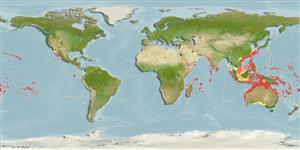Actinopterigi (pesci con pinne raggiate) >
Perciformes (Perch-likes) >
Serranidae (Sea basses: groupers and fairy basslets) > Epinephelinae
Etymology: Variola: Latin, variolus = pustule, pock (Ref. 45335).
Ambiente / Clima / Range
Ecologia
; marino associati a barriera corallina; non migratori; distribuzione batimetrica 3 - 300 m (Ref. 89972), usually 15 - ? m (Ref. 5222). Tropical, preferred 27°C (Ref. 107945); 30°N - 37°S, 30°E - 23°W (Ref. 5222)
Indo-Pacific: Red Sea to South Africa and the Pitcairn Islands, north to southern Japan, south to New South Wales, Australia. Not found in the Persian Gulf nor in Hawaii.
Length at first maturity / Size / Peso / Age
Maturity: Lm ?, range 41 - ? cm
Max length : 83.0 cm TL maschio/sesso non determinato; (Ref. 40637); common length : 75.0 cm TL maschio/sesso non determinato; (Ref. 5450); Peso massimo pubblicato: 12.0 kg (Ref. 5222)
Spine dorsali (totale): 9; Raggi dorsali molli (totale): 13-14; Spine anali 3; Raggi anali molli: 8. Juveniles conspicuous by the white line over the snout (Ref. 48635). Further characterized by yellowish brown to orange red color with numerous red, pink and lavander small spots and short dashes; pectoral, dorsal, anal and caudal fins with yellow posterior margin; front of jaws with pair of large canines; 1-2 large curved canineson side of lower jaw; elongate body, greatest depth 2.8-3.2 in SL; lunate caudal fin (Ref. 90102).
Usually seen in clear-water areas at depths below 15 m, and prefers islands and offshore reefs rather than continental shores. Feeds mainly on fishes, and on crabs, shrimps and stomatopods. It is highly appreciated for the quality of its flesh. It may not be sold in Mauritius because of cases of ciguatera poisoning (Ref. 11888). In the Hong Kong live fish markets (Ref. 27253).
Life cycle and mating behavior
Maturità | Riproduzione | Deposizione | Uova | Fecundity | Larve
Heemstra, P.C. and J.E. Randall, 1993. FAO Species Catalogue. Vol. 16. Groupers of the world (family Serranidae, subfamily Epinephelinae). An annotated and illustrated catalogue of the grouper, rockcod, hind, coral grouper and lyretail species known to date. Rome: FAO. FAO Fish. Synop. 125(16):382 p. (Ref. 5222)
IUCN Red List Status (Ref. 115185)
CITES (Ref. 94142)
Not Evaluated
Threat to humans
Reports of ciguatera poisoning (Ref. 4690)
Human uses
Pesca: commerciale; Pesce da pesca sportiva: si; Acquario: Commerciale
Informazioni ulteriori
BibliografiaAcquacolturaProfilo di acquacolturaVarietàGeneticaFrequenze allelicheEreditarietàMalattieElaborazioneMass conversion
Strumenti
Special reports
Download XML
Fonti Internet
Estimates of some properties based on models
Phylogenetic diversity index (Ref.
82805): PD
50 = 0.7500 [Uniqueness, from 0.5 = low to 2.0 = high].
Bayesian length-weight: a=0.01023 (0.00685 - 0.01528), b=3.04 (2.93 - 3.15), in cm Total Length, based on LWR estimates for this species & (Sub)family-body (Ref.
93245).
Trophic Level (Ref.
69278): 4.3 ±0.7 se; Based on diet studies.
Resilienza (Ref.
69278): Medio, tempo minimo di raddoppiamento della popolazione 1.4 - 4.4 anni (K=0.18).
Vulnerability (Ref.
59153): Low to moderate vulnerability (33 of 100) .
